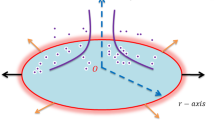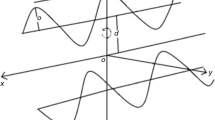Abstract
Current communication is addressed to elaborate features of laminar fluid flowing through a channel with permeable boundaries which is an important flow problem in real-world applications. In this work, Newtonian fluid (base fluid) in a rotating porous contracting/expanding channel with induction of TiO2-Cu nanoparticles (Suspensions) of different shapes and sizes is obliged. Formulation is executed under implementing boundary layer approach. Empirical relation representing features of nanoparticles are added in equations. Afterwards, partial differential expressions are changed into ODE’s by incorporating transformations. Solution is heeded by collaboration of R–K and shooting procedure. The impact of flow-controlling parameters is interpreted via graphs and tables. The important quantities of engineering interest like heat flux coefficient, skin friction against different parameters are explained in tabulated manner. To make results more credible different range of nanoparticles volumetric fractions (1–4)%, and different shapes of particles like, i.e., triangle, oval, prism, hexagonal, spherical, brick, cylinders, and platelets are considered. It is inferred from investigation that magnitude of heat transfer coefficient has gained optimization against concerning parameters for the platelet shape of nanoparticles. It is revealed that magnitude of wall drag force and heat flux at lower boundary of channel is more inthe case of contraction than to the expansion of channel.










Similar content being viewed by others
Abbreviations
- u, v:
-
Velocity components (m/s)
- T:
-
Temperature (K)
- v hnf :
-
Hybrid nanofluid kinematic viscosity(m2/s)
- (Cp)hnf :
-
Hybrid nanofluid specific heat (J kg−1k−1)
- α :
-
Stretching rate
- B o :
-
Magnetic field strength
- φ1,φ2 :
-
Nanoparticles volume fraction
- ρ bf :
-
Water density (base fluid)(kgm−3)
- ρ s1 ,ρ s2 :
-
Density for nanoparticles 1 and 2
- K:
-
Thermal conductivity(W k−1 m−1)
- k s1 ,k s2 :
-
Thermal conductivity for nanoparticles (TiO2,Cu)
- K mbf :
-
Shape factor for thermal conductivity base fluid
- M:
-
Magnetic field (A/m)
- A vp :
-
Axial velocity profile
- T p :
-
Temperature profile
- Pr :
-
Prandtl number
- Re :
-
Reynolds number
- R0 :
-
Rotational parameter
- N:
-
Size
- Ω:
-
Angular speed
- x, y:
-
Space coordinate
- ρ hnf :
-
Hybrid nanofluid density
- k hnf :
-
Hybrid nanofluid thermal conductivity
- μf :
-
Water dynamic velocity(Ns m–1)
- B fd :
-
Base fluid
- α hnf :
-
Thermal diffusivity hybrid nanofluid
- Re r :
-
Local Reynolds number
- ς y :
-
Shear stresses
- R VP :
-
Redial velocity profile
- N fd :
-
Nanofluid
References
Afify AA (2015) Slip effects on the flow and heat transfer of nanofluids over an unsteady stretching surface. J Comput Theor Nanosci 12:484–491
Afolalu SA, Soetan SB, Ongbali SO, Abioye AA (2019) Oni AO Morphological characterization and physio-chemical properties of nanoparticle – review. Conf Series Mater Sci Eng 640(012065):1–12
Ahmad S, Nadeem S (2020) Flow analysis by Cattaneo-Christov heat flux in the presence of Thomson and troian slip condition. Appl Nanosci 1:3
Ahmad S, Khan MI, Hayat T, Khan MI, Alsaedi A (2018) Entropy generation optimization and unsteady squeezing flow of viscous fluid with five different shapes of nanoparticles. Data Colloids Surf A Physicochem Eng Aspects 34:197–210. https://doi.org/10.1016/j.colsurfa.(2018).06.017554
Akbar MZ, Ashraf M, Iqbal MF (2016) Heat and mass transfer analysis of unsteady MHD nanofluid flow through a channel with moving porous walls and medium. AIP Adv 6(4):045222
Akinshilo AT (2020) Geometry shape effects of nanoparticles on fluid heat transfer through porous channel. AUT J Mech Eng 4(1):41–50
Akram J (2020) Akbar NS, Tripathi D Numerical study of the electroosmotic flow of Al2O3–CH3OH Sisko nanofluid through a tapered microchannel in a porous environment. Appl Nanosci 10:4161–4176
Albanese A, Peter S, Warren CW (2012) The effect of nanoparticle size, shape, and surface chemistry on biological systems. Annu Rev Biomed 14:1–16
Aliofkhazraei M (2016) Hand book of Nanoparticles. Springer International Publishing, London
Aminian E, Moghadasi H (2020) Saffari H Magnetic field effects on forced convection flow of a hybrid nanofluid in a cylinder filled with porous media: a numerical study. J Therm Anal Calorim 141:1–13
Babu R, Kumar K (2017) State-of-art review on hybrid nanofluids. Renew Sustain Energy Rev 77:551–565
Bhattad A (2019) Effects of nanoparticle shape and size on the thermohydraulic performance of plate evaporator using hybrid nanofluids. J Therm Anal Calorim 142(5):1–13
Bhatti MM, Sheikholeslami M, Shahid A, Hassan M (2019) Entropy generation on the interaction of nanoparticles over a stretched surface with thermal radiation. Colloids Surf A 570:368–376
Chamkha AJ, Dogonchi AS (2019a) Magneto-hydrodynamic flow and heat transfer of a hybrid nanofluid in a rotating system among two surfaces in the presence of thermal radiation and Joule heating. AIP Adv 3(2):7
Chamkha AJ, Sazegar S, Jamesahar E (2019b) Thermal non-equilibrium heat transfer modeling of hybrid nanofluids in a structure composed of the layers of solid and porous media and free nanofluids. Energies 12(3):1–27
Choi SUS (1995) Enhancing thermal conductivity of fluids with nanoparticles. ASME Internat Mech Eng Cong Exp 231:99–106
Das SK, Choi SUS, Yu W (1995) Nanofluids science and technology. Wiley, NY
Dinarvand S, Rostami MN, Pop I (2019) A novel hybridity model for TiO2- CuO/water hybrid nanofluid flow over a static/moving wedge or corner. Scient Rep 9:5
Eastman JA, Choi SUS, Li S, Yu W (2001) Anomalously increased effective thermal conductivities of ethylene glycol-based nanofluids containing copper nanoparticles. Appl Phys Lett 78(6):718
Haryadi BM, Hafner D, Amin I, Schubel R, Jordan R, Winter G (2019) Nonspherical nanoparticle shape stability is affected by complex manufacturing aspects: its implications for drug delivery and targeting. Adv Healthcare Mater 2:1–21
Hayat T (2017) Heat transfer enhancement with Ag-CuO/water hybrid nanofluid. Res Phys 7:2317–2324
Hayat T, Nadeem S (2018) An improvement in heat transfer for rotating flow of hybrid nanofluid: a numerical study. Can J Phys 96(12):1420–1430
Hayat T, Nadeem S, Khan AU (2018) Rotating flow of Ag-CuO/H2O hybrid nanofluid with radiation and partial slip boundary effects. Eur Phys J E 41(75):9
Hosseinzadeh K, Afsharpanah F, Zamani S, Gholinia M, Ganji DD (2018a) A numerical investigation on ethylene glycol-titanium dioxide nanofluid convective flow over a stretching sheet in presence of heat generation/absorption. Case Studies Thermal Eng 12:228–236
Hosseinzadeh K, Alizadeh M, Ganji DD (2018b) Hydrothermal analysis on MHD squeezing nanofluid flow in parallel plates by analytical method. Internat J Mech Mater Eng 13(4):1–13
Iqbal Z, Akbar NS, Azhar E, Maraj EN (2018) Performance of hybrid nanofluid (Cu-CuO/water) on MHD rotating transport in oscillating vertical channel inspired by Hall current and thermal radiation. Alex Eng J 57(3):1943–1954
Izadi M, Mohebbi R, Delouei AA (2018) Natural convection of a magnetizable hybrid nanofluid inside a porous enclosure subjected to two variable magnetic fields. Int J Mech Sci 151:151–169
Jeong J, Li C, Kwon Y, Lee J, Kim SH (2013) Yun R Particle shape effect on the viscosity and thermal conductivity of ZnO nanofluids. Int J Refrig 36(8):2233–2241
Kabeel AE, Maaty TAE, Samadony YE (2013) The effect of using nano-particles on corrugated plate heat exchanger performance. Appl Therm Eng 52:221–229
Kang UK, Kim SH (2006) Estimation of thermal conductivity of nanofluid using experimental effective particle. J Therm Energy Gen Trans Storage Conv 19(3):181–191
Kumar R, Kumar R, Sharma T, Sheikholeslami M (2021) Mathematical modeling of stagnation region nanofluid flow through Darcy–Forchheimer space taking into account inconsistent heat source/sink. https://link.springer.com/journal/1219065(2021)713–734.
Kwak K (2005) Kim C Viscosity and thermal conductivity of copper oxide nanofluid dispersed in ethylene glycol. Korea Aust Rheol J 17:35–40
Li Z, Selimefendigil F, Sheikholeslami M, Shafee A (2020) Hydrothermal analysis of nanoparticles transportation through a porous compound cavity utilizing two temperature model and radiation heat transfer under the effects of magnetic field. Microsyst Technol 26:333–344
Liu LH, Yu W, Xie H (2012) A review on nanofluids: preparation, stability mechanisms, and applications. J Nanomater 2(435873):17
Madhesh D, Kalaiselvam S (2014) Experimental analysis of hybrid nanofluid as a coolant. Proc Eng 97:1667–1675
Magalakwe G, Lekoko ML, Modise K (2019) CM Lie group analysis for MHD squeezing flow of viscous fluid saturated in porous media. Alex Eng J 58(3):1001–1010
Manjunatha B, Kuttan S, Jayanthi S, Chamkha A, Gireesha BJ (2019) Heat transfer enhancement in the boundary layer flow of hybrid nanofluids due to variable viscosity and natural convection. Heliyon 5(4):e01469
Marin HM, Abdullah Alsharif R (2018) Convective heat transfer flow of nanofluid in a porous medium over wavy surface. Phys Lett A 382(38):2749–2753
Minea AA (2016) A review on the thermophysical properties of water-based nanofluids and their hybrids, the annals of Dunarea De Jos. Univ Galati 83(1):35–47
Mollamahdi M, Abbaszadeh M (2016) Analytical study of Al2O3-Cu/water micropolar hybrid nanofluid in a porous channel with expanding/contracting walls in the presence of magnetic field. Scient Iran 25(1):1–22
Rashidi MM, Reza M (2016) MHD stagnation point flow of micropolar nanofluid between parallel porous plates with uniform blowing. Powder Tech 301:876–885
Saba F, Ahmed N, Khan U, Waheed A, Rafiq M (2018) Thermophysical analysis of water based (Cu–Al2O3) hybrid nanofluid in an asymmetric channel with dilating/squeezing walls considering different shapes of nanoparticles. Appl Sci 8(9):1579
Sarma D (2019) Effects of Hall current, rotation and Soret effectson MHD free convection heat and mass transfer flow past an accelerated vertical plate through a porous medium. Ain Shams Eng J 9:89
Septiadi WN, Nyoman IA, Trisnadewi T, Putra N (2018) Synthesis of hybrid nanofluid with two-step method. ES Web Conf 67(03057):1–7
Shafiq A, Rasool G, Phali L, Khalique CM (2020) Thermosoluted marangoni convective flow towards a permeable Riga surface. DE Gruyter 18(1):535–544
Sheikholeslami M (2013) Ganji DD Heat transfer of Cu-water nanofluid flow between parallel plates. Powder Technol 235:873–879
Sheikholeslami M (2019) New computational approach for exergy and entropy analysis of nanofluid under the impact of Lorentz force through a porous media. Comput Methods Appl Mech Eng 344:319–333
Sheikholeslami M, Hatami M (2013) Analytical investigation of MHD nanofluid flow in a semi-porous channel”. Powder Technol 246:327–336
Sheikholeslami M, Rezaeianjouybari B, Darzi M, Shafee A, Li Z (2019a) Application of nano-refrigerant for boiling heat transfer enhancement employing an experimental study. Int J Heat Mass Transf 141:974–980
Sheikholeslami M, Shafee A, Zareei A, Haq R (2019b) Heat transfer of magnetic nanoparticles through porous media including exergy analysis. J Mol Liquids 279:719–732
Sheikholeslami M, Jafaryar M, Said Z, Alsabery AI, Babazadeh H (2021) Modification for helical turbulator to augment heat transfer behavior of nanomaterial via numerical approach. Appl Therm Eng 182(5):1–18
Subhani M (2019) Numerical analysis of micropolar hybrid nanofluid. Appl Nanosci 9:447–459
Wang XQ (2008) A review on nanofluids - part I: theoretical and numerical investigations. Braz J Chem Eng 25(4):1678–4383
Williams HM (2017) The application of magnetic nanoparticles in the treatment and monitoring of cancer and infectious diseases. Biosci Horiz Internat J Student Res 10:1–10
Yao H, Fan M, Wang Y, Luo G (2015) Fei J Magnetic titanium dioxide based nanomaterials: synthesis, characteristics, and photocatalytic application in pollutant degradation. J Mater Chem A 3(34):17511–17524
Yousefi M, Dinarvand S, Yazdi ME (2018) Pop I Stagnation-point flow of an aqueous titania-copper hybrid nanofluid toward a wavy cylinder. Internat J Num Methods Heat 28(7):1716–1735
Zhou M, Xia G, Li J, Chai L, Zhou L (2012) Analysis of factors influencing thermal conductivity and viscosity in different kinds of surfactant solutions. Exp Therm Fluid Sci 36:22–29
Author information
Authors and Affiliations
Corresponding author
Ethics declarations
Conflict of interest
The author has no conflict of interest of any type to anyone.
Additional information
Publisher's Note
Springer Nature remains neutral with regard to jurisdictional claims in published maps and institutional affiliations.
Rights and permissions
About this article
Cite this article
Bilal, S. Analysis about impact of morphological and nanoparticle volume fraction aspects of TiO2–Cu in enhancement of thermo-physical features of newtonian fluid flowing in a rotating porous channel. Appl Nanosci 13, 405–419 (2023). https://doi.org/10.1007/s13204-021-01770-2
Received:
Accepted:
Published:
Issue Date:
DOI: https://doi.org/10.1007/s13204-021-01770-2




